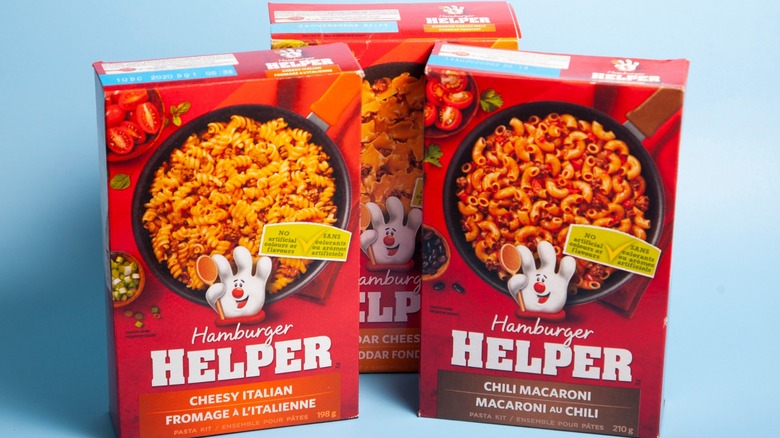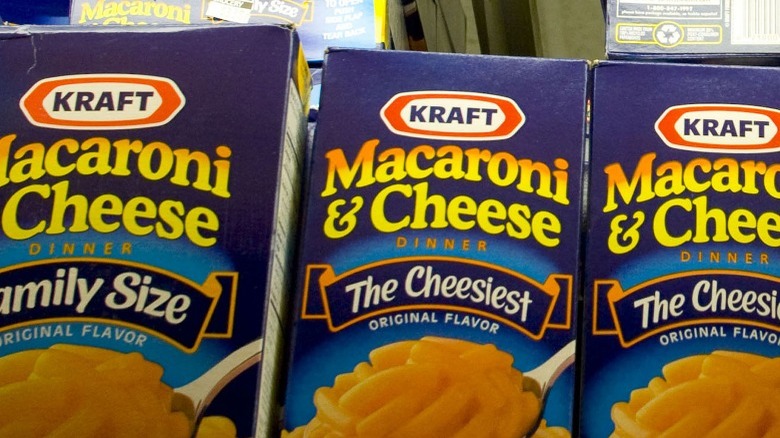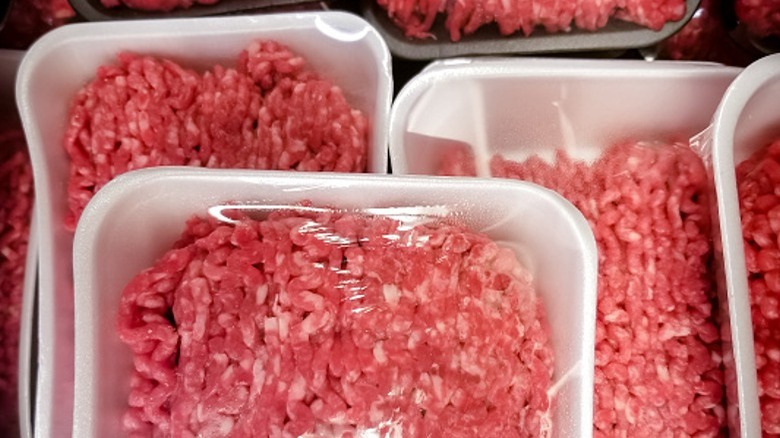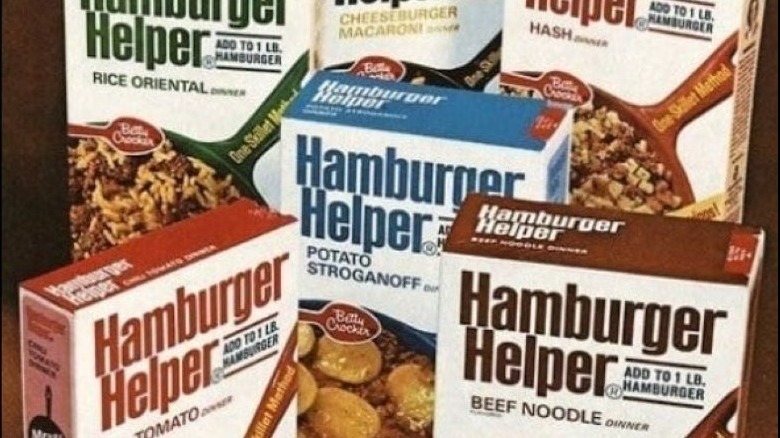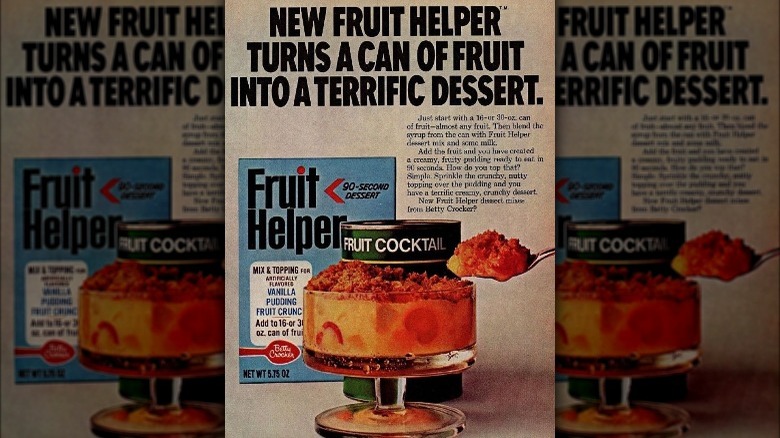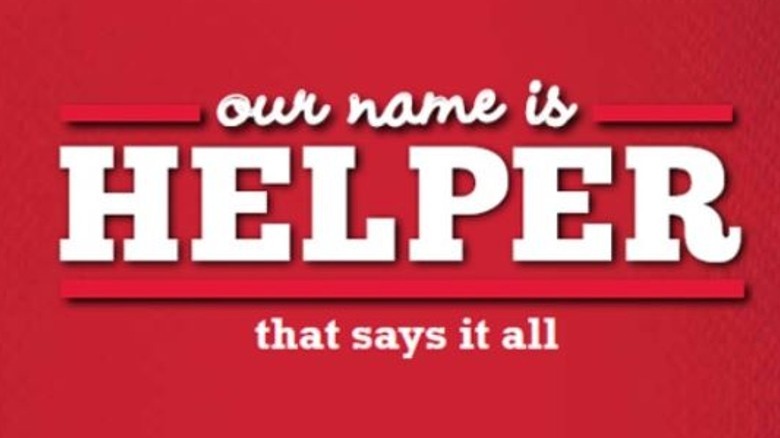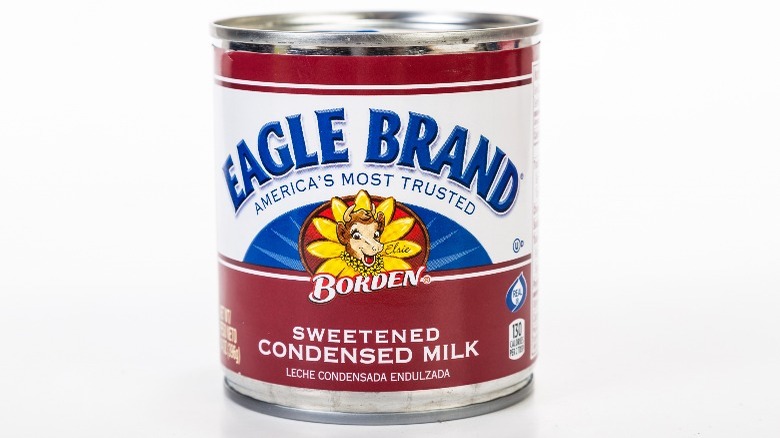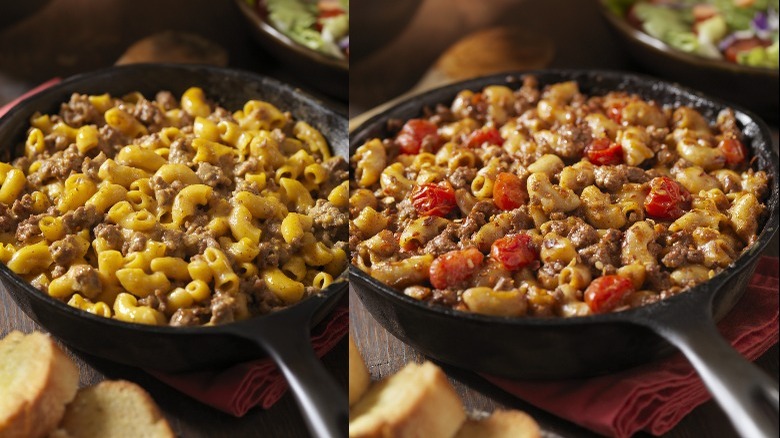The Fascinating History Of Hamburger Helper
Whoever dreamed up the phrase Hamburger Helper must have been a genius — because there's no other food product that's so perfectly named. Though this grocery store mainstay was created to meet the market conditions of the 1970s, it has carved out a strong niche for itself that's stood the test of time. Around for more than 50 years, this packaged dry meal kit has a history that's both surprising and interesting. It has evolved from its first incarnation, changing recipes, packaging — and even its owners.
These kits still connect with consumers who appreciate the convenience that first made Hamburger Helper such a fad. The basic instructions involve browning ground beef, draining it, and adding the other ingredients — in just one pan. Then the heat's increased to boiling and reduced to a simmer. Imagine how excited consumers must have been when it was introduced. Hamburger Helper was the first of its kind and cut meal preparation time down significantly. It's also versatile because you can substitute cut-up hot dogs for beef, swap out other ingredients, and add different toppings (like sour cream).
The company that first made Hamburger Helper experienced great success with this innovative product, so it wasn't long before competitors came up with their own versions. Examples include Velveeta Cheesy Skillets, Rice-a-Roni, and Progresso Recipe Starters. But this was the first, and its fans still think that it's the best. Here's how the whole thing got started.
General Mills and Hamburger Helper
Hamburger Helper was introduced by General Mills, one of the biggest manufacturers of packaged foods on the planet. Its main products are cereal, flour, snack, and kits like Hamburger Helper. Based in Minneapolis, it started as a flour-milling company in 1866 known as Washburn-Crosby. It was built by a man named Cadwallader Washburn and was the largest flour mill in the region.
A second mill was built, and both were incorporated with four other companies about 60 years later. And — unlike the many large companies that disappeared during The Great Depression and Second World War — General Mills has held its marketplace position.
Some of its earliest brands are still around today, like Gold Medal Flour, Cheerios, and Wheaties. In the 1960s, the company started selling snack foods, but it expanded significantly in 1997 and 2001. Those are the years that General Mills acquired Ralston Purina's Chex cereal and Pillsbury. Now, it has more than 100 brands on six continents. Just look for its simple cursive capital G logo — it's amazing how many products have this.
The real Betty Crocker
Even with General Mills as its manufacturer, people thought that Hamburger Helper was made by Betty Crocker. However, Betty wasn't a real person. She was (and is) one of the company's brands, and was "born" even before General Mills. Ingenious advertising execs came up with the Betty idea in 1921. Here's how it happened.
Washburn-Crosby was already selling Gold Medal Flour and was running a promotion for consumers to win flour bag-shaped pincushions. Respondents wrote down cooking questions and included them with their mailed-in entries. The advertising department helped create a female brand persona to answer the questions, with the idea that she would be someone consumers could relate to. They named it Betty Crocker, after retired exec William G. Crocker.
One of the company's female employees signed the response letters and soon after, there were Betty Crocker-sponsored cooking schools and radio shows with different actors. There were also test kitchens, popular cookbooks, and an actress who played Betty on a TV show from 1949 to 1964.
The first Betty Crocker product was brought to market in 1942: a dried soup mix. But the packaged cake mixes really took off and are still a best-seller. The brand had a logo with the name in a bright red spoon. This too evolved over time. It's still on the packaged cake and cookie mixes, Bisquick, and other products. However, it hasn't been on Hamburger Helper for a long while because something else took its place.
Precursors to Hamburger Helper
Kraft is one of General Mill's biggest competitors. The brand hit it out of the park when Kraft Macaroni and Cheese was created. Of course, the combination of those two ingredients was nothing new, as people had been eating them together for centuries. Cheese salesman James L. Kraft recognized the problem of cheese spoiling too fast without refrigeration and explored the possibility of extending its shelf life. Enter two Swiss chemists, Fritz Stettler and Walter Gerber. In 1913, they experimented with adding sodium citrate to cheese and saw that it melted easier. The same thing happened with butter.
Mr. Kraft got the original patent for processed cheese that same year, after he had heated cheddar cheese scraps and added sodium phosphate. He sold this to the U.S. Army. Later, Kraft introduced Cheez Whiz and Velveeta. But to make a mac and cheese product, the cheese needed to be defatted partially and dehydrated. Kraft Macaroni and Cheese came out in 1937.
Hamburger Helper has much in common with that product, since it also comes with a sauce packet and a starch — only, it is supposed to be made with a protein. Still, Betty didn't get it right the first time. In 1967 a boxed dinner was released, but it wasn't quite convenient enough to catch on. The different parts needed to be cooked in separate pans instead of just one, and it took the company four more years to get it right.
The price of beef skyrocketed in the 1970s
Another factor that pushed the fine-tuning of Hamburger Helper was skyrocketing beef prices in the early 1970s. Though chicken and pork prices were on the rise, but the cost of buying cows was even higher. Buying a purebred cow for breeding could run into thousands of dollars. At the time, unemployment was also a national problem. With the price of beef at record levels, something was bound to happen.
The demand for beef was still strong, even though prices were high and people were out of work. Those rising costs were a symptom of The Great Inflation, which ran from 1965 to 1982. And on top of all that, a jump in oil prices also contributed to soaring food costs and ongoing consumer misery. The timing couldn't have been better for Hamburger Helper. Here was a packaged mix that could stretch out a pound of regular ground beef into enough servings for a small family. Ground beef is less expensive than steaks and chops, and the side dish was part of the deal.
Marjorie Johnson was the brainchild behind Hamburger Helper
Betty Crocker introduced internationally-inspired dinner mixes in 1967, with names like Rice Keriyaki (not teriyaki), Noodles Cantong, and Macaroni Monte Bello. Strange names indeed, and certainly not as catchy as Hamburger Helper. Unsurprisingly, these concoctions didn't resonate with the general public. The blueprint for Hamburger Helper was created by a home economist named Marjorie Johnson. Her mother struggled to feed Marjorie's family, and that served as Johnson's inspiration. As the legend goes, Marjorie outlined her idea for combining ground beef with a dry mix and sent a letter to General Mills. Soon enough, she was working with the company to develop the product.
The first Hamburger Helper versions were introduced in 1970 on the West Coast. A marketing plan was needed to get the word out. Marjorie was enlisted to appear on TV ads and start giving interviews. Consumers were excited to learn that one pound of ground beef could be used to feed their families and Hamburger Helper became a food staple in countless kitchen pantries.
The first Hamburger Helper flavors
The Hamburger Helper brand was introduced to the rest of the United States in the summer of 1971. The first flavors sounded more palatable than the original dinner mixes, including Chili Tomato, Potato Stroganoff, Rice Oriental, Beef Noodle, and Hash. Each box was a different color, and the chili tomato was the only original one that featured macaroni pasta. Cheeseburger Macaroni came out in 1973. And once there were six, there were flavors for almost every day of the week.
Over the years, there were other hits but some misses as well. Tuna Helper was launched a year earlier and is still out there — a quick, easy way to make hot tuna pasta dishes without an oven. Chicken Helper also survived, but Pork Helper cannot be found anymore. And what's more, the package sizes may have shrunk, too. The original Beef Noodle had 7 ounces, and today's Beef Pasta has 5.9 ounces. Other here-and-then-gone flavors were Whole Grain Helper and Asian Helper.
There was even a Fruit Helper
A few people might remember 1973's Fruit Helper, which had an awkward-sounding name and little success. It was essentially a topping mix that could be added to canned fruit. Two of the flavors were Coconut Pudding Fruit Crunch and Strawberry Fruit Crunch.
These dessert mixes were advertised as 90-second desserts. They contained sugar, modified corn starch, and other ingredients like coconuts, pecans, soybean oil, and artificial flavors and colors. To make it, you had to drain the fruit and add the packaged mix to the reserved syrup before adding the crunchy toppings. The package might have also shown a recipe to use with frozen fruit, too. The idea behind this might have sounded good — but in reality, it didn't save much time. It doesn't sound like it tasted that great, either. Consequently, Fruit Helper didn't please consumers, so General Mills made it go away — just like its Pork Helper.
Meet Lefty
Some of the most famous brand mascots of all time include the Pillsbury Doughboy (Poppin' Fresh), Mr. Clean, Tony the Tiger, and the GEICO Gecko. Iconic characters like these help products become more relatable and memorable, so it wasn't long before one started appearing on Hamburger Helper packages.
Lefty was introduced in 1977, a cute, puffy, white-gloved hand with a clown-like red nose, two eyes, and a mouth on the palm. It had a thumb, but only four fingers. Perhaps the extra one was left on intentionally to spark debate but in any case, it was a success. Lefty was used on Hamburger Helper labels and was seen dancing around in commercials as recently as 2022. It was also updated with a tongue and a thumb-held wooden spoon. There was even a Lefty mixtape in 2016 and a Twitter feed. Lefty is still seen holding the spoon on the product packages sold today — and actually, it's kinda cute.
The word hamburger was dropped from the name
In 2013, General Mills execs reconsidered the brand name Hamburger Helper, deciding that it was limiting. Since the words hamburger and helper sounded so good together, it makes sense that consumers might not be as drawn to chicken helper, tuna helper, and so forth. Consumers were also eating more chicken, so that fact became part of the strategy. At the time, the company reported that even though 1 million homes were eating it each night, sales had decreased by 14%.
So the word 'hamburger' was given less importance and the brand simply became Helper. The packaging was revamped and more chicken mix flavors were added, too. Another line was also added: Ultimate. That product included sauce pouches (and is still in the product line today).
How are the labels different? On the first packages, both words were the same size. Now, Helper is larger and the word above it is smaller. So even though the name has changed technically, the other words are still included for clarification. And in any case, people still refer to it as Hamburger Helper. The new branding just serves to include a wider range of lifestyles.
Eagle Brands bought Hamburger Helper
The name-changing might have been an indication that Betty Crocker would eventually be parting ways with Hamburger Helper, since sales had decreased. In July of 2022, Eagle Family Foods Group LLC acquired Helper main meals and Suddenly Salad from General Mills. Mainly known for its canned milk products and a few packaged snack foods, Eagle Brands was originally part of The J.M. Smucker Company. The brand is now owned by Kelso & Company.
The transaction was made for a price of $610 million and was supposed to close in 2023. Two years before that, General Mills reported that the sales for both product lines had amounted to $235 million. That same year, the company also bought TNT crust, a company that makes frozen pizza crusts. Eagle wanted to diversify its portfolio into meals and sides. The company claimed that it would be expanding the positioning of the new brands.
It used social media to attract male consumers
When Hamburger Helper was first introduced, it was designed to appeal to working mothers who cooked for their families. But times change and General Mills wanted to target young men who'd be interested in the easy preparation and convenience. The company's research revealed that young men were, in fact, buying the products — but the execs wanted to build up the market. So as part of the 2013 rebranding, Helper was to focus more on men aged 18 to 30.
This was done through a social media campaign, including Lefty's Facebook page and Twitter account. There was also a tie-in marketing program with the Real Men Cook TV show. The overall goal was to draw in more male customers, whether they were young singles or parents. It made sense, since moms in their 30s and 40s aren't the only ones who want convenient options for lunch and dinner.
The current lineup
Called "America's favorite one-pan meal," Helper's meals can be categorized by protein and flavor type. There are more than 25 beef meals, including stroganoff, sweet bbq, and bacon (thank you) cheeseburger macaroni. The only two chicken versions at this time are fried rice and fettucini alfredo. However, there are five tuna options, including cheesy pasta and creamy broccoli. The tuna line expanded a while back to include cheesy enchilada, crunchy taco, and tuna tetrazzini.
The original price of Hamburger Helper was about 65 cents. After all this time, it's still affordable — even if the price has almost tripled. We found a 6.6-ounce Hamburger Helper Cheeseburger Macaroni at Target priced at $1.79. And with a pound of ground beef, it can still feed a family of four for less than 10 bucks. General Mills launched microwavable singles in 2006, which are made with beef and only need a bit of water. These come in a 1.6-ounce size and are sold in selected grocery stores, as well as online retailers.
